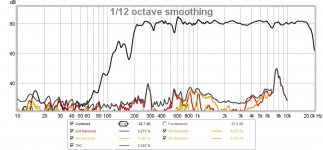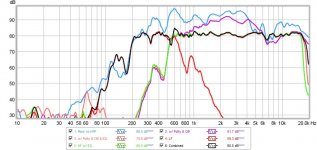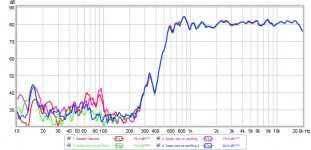William (Cowanaudio),
DSP would be essential to getting something close to time alignment of the bass horn to the multiple entrant (mid/high) horn.
G'day Phil
I use the Hypex Fusion amps in there. They have inbuilt DSP. The bass/mid time alignment is the easy part.
How far down were you able to push the "multiple entrant horn" at 7 feet across I am figuring in the low hundreds of Hz.
A bit below 150Hz. It was two years ago I set up those two systems so I don't remember the exact figure. There is a triplet of potent 98dB/W/M B&C 6" drivers in there that I can lean on pretty hard. Not a lot of horn loading is available to the mids at the crossover point but the sensitivity is still pretty high..
While I was using the bass horns I kept toying with the idea of building a bass/ mid horn. That transition from the sub, which you KNOW will be damn big, to a bass/bid horn is always a challenge.
I like to get down as low as possible in one horn. A good MEH will go low enough to cross to a bass horn. I did some two way MEHs for a club in Canberra that cross at 80Hz. They use the 8ndl51 crossed to a BMS4550. Those speakers are passive. You have the knowledge to pull one off too, it just requires a bit of thought and a few simple experiments.
Last edited:
Okay. Understood.
But what differentiates a Unity Horn from any other MEH? I'm new to the concept and find the differences confusion. Even difference between Unity and Synergy is quite confounding.
The Unity horn patent has expired. Many MEHs use ideas that appeared in that patent. I agree that the difference between a Unity horn and a Synergy horn is confounding. Nothing that appears in the claims for the Unity patent is enforceable in the Synergy patent, apparently. I'm not entirely sure what is left. My crossovers are unique and our internal structure and waveguides are markedly different too and driven by our own development.
The Unity horn patent has expired. Many MEHs use ideas that appeared in that patent. I agree that the difference between a Unity horn and a Synergy horn is confounding. Nothing that appears in the claims for the Unity patent is enforceable in the Synergy patent, apparently. I'm not entirely sure what is left. My crossovers are unique and our internal structure and waveguides are markedly different too and driven by our own development.
You use a waveguide profile other than a straight sided cone?
I made a Synergy with an open back mid and it sounded great. Perhaps one of the best speakers I have heard. The Heil AMT tweeter had a rear Dagger sealed chamber though. Mid was a single B&C 6MDN44.
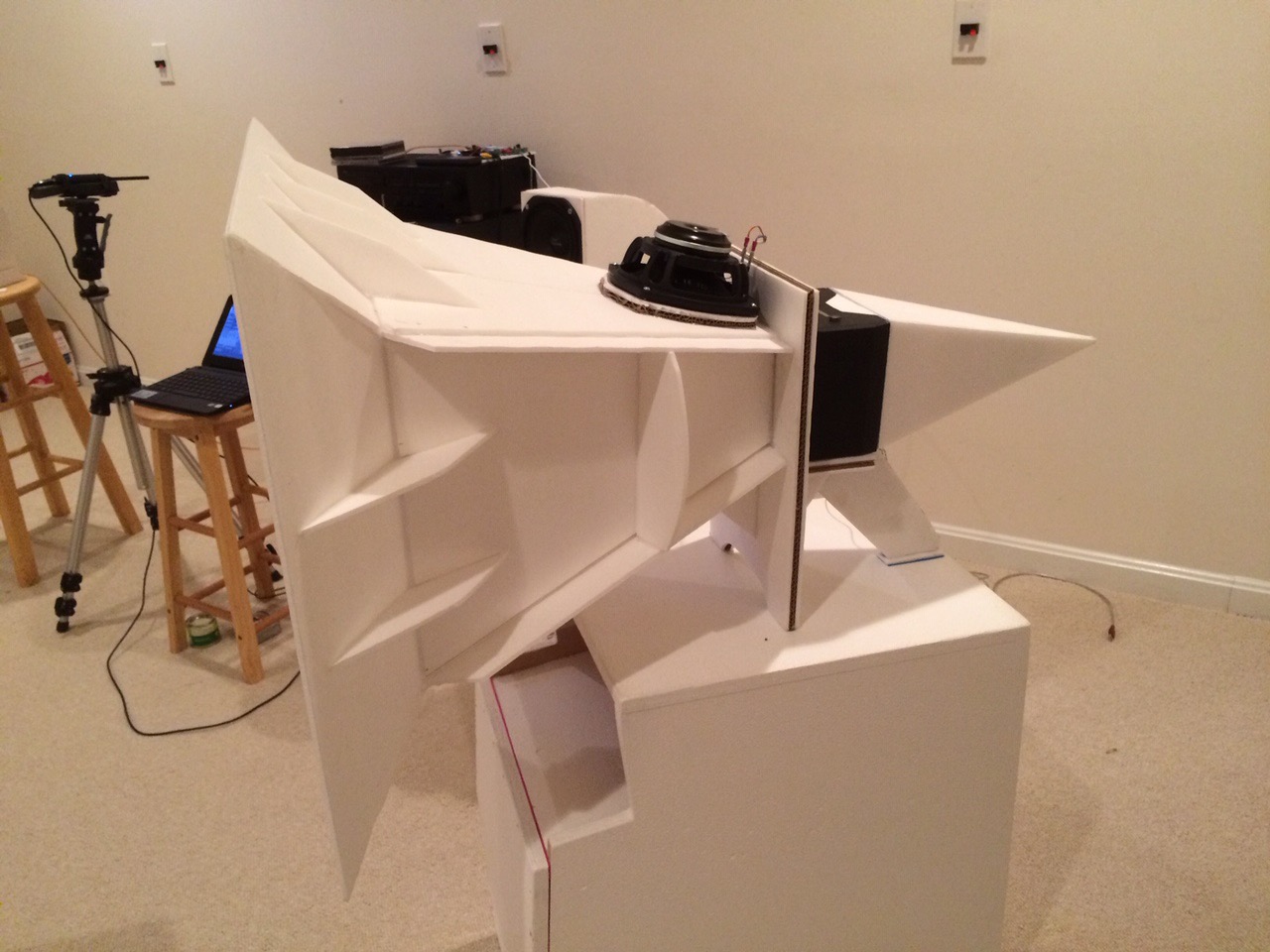
Do you not have trouble with a conusspeaker as compression driver behind the synergy? like loosing high much sooner as a normal driver.
regards
I love the way yours turned out. I am going to be building 3 synergy horns too...1 without a box, and 1 with a box, and then go with which ever one I want for all of them after listening, and tunng with REW.I made a Synergy with an open back mid and it sounded great. Perhaps one of the best speakers I have heard. The Heil AMT tweeter had a rear Dagger sealed chamber though. Mid was a single B&C 6MDN44.

I made a Synergy with an open back mid and it sounded great. Perhaps one of the best speakers I have heard. The Heil AMT tweeter had a rear Dagger sealed chamber though. Mid was a single B&C 6MDN44.

I still think that particular horn would make a very popular kit. The looks of it with some colored panels used are about as eye catching as they come. For people without SOs that aren't too picky of course.
I made a Synergy with an open back mid and it sounded great. Perhaps one of the best speakers I have heard. The Heil AMT tweeter had a rear Dagger sealed chamber though. Mid was a single B&C 6MDN44.

This looks awesome in every way. Thanks for sharing.
Can you share the response curves? I was beginning to step back owing to the fact that a open back might not load the ports well enough and the fact that the horn profile doesn't make for a large enough baffle to limit the cancellation of the front and back waves.
Far more interesting is the fabrication method. What are the materials and methods used for fabricating this horn?
Also, I understand that the throat of the horn is determined by the lowest wavelength. Given the size of AMT, does it couple well with the horn at the highest frequencies?
I also feared that there would be a cancellation issue, but keep in mind the front to back is a round-trip from driver to horn mouth rim and back. In my case the rountrip is about 36in so the 1/2-wave cancellation is 187Hz, about the same as th useful bandwidth of the 6MDN44 midrange that I was using. It actually made for a nice natural filter for the crossover to the front loaded horn I have below which can go up to 250Hz and they integrate well. If you wanted to do it with a couple of woofer/mids like a 10HP300 or something like that to reach down to say, 80Hz, you would indeed need a cover to prevent the cancellation. I did that with my Trynergy and used a cheap 6.5in polycone woofer.
This particular speaker was a prototype foam-core construction pathfinder for the wooden version of a commissioned design, so I can't give too many details. Although anyone who knows how to use Bwaslo's synergy horn spreadsheet can make the same thing without too much trouble. The pertinent design specs are a 30in wide x 21in tall horn mouth, 21in deep, and throat size to match the Heil AMT aperture. The tricky part is the transition from the AMT to the throat of the horn. I used putty to smooth it out, but nowadays, I would 3d print a transition throat. I ran into the same problem with the bookshelf point soure horn. A good throat adapter that is smooth and transitions the tweeter to the horn wall is critical. Because I did not have that perfected, there was a dip neat 7500Hz corresponding to a 1.8in distance from AMT center to the horn wall. This also showed up the HD which peaks there. I ran a rather low XO freq of 600Hz, which works because the Heil AMT can go down pretty low. So the mid range handled the 200Hz to 600Hz range and the AMT took care of things above that. In retrospect, I think an 800Hz XO would have been better and put less strain on the AMT. Also, if you used a TPL-150 or something like thgat they cant cross low and need maybe 1500Hz or 2000Hz even. The TPL-150H already has a horn transition and take that and add it to your synergy. Use a pair of SB23's for the mid-woofers and you have a very potent 2-way that only needs a sub below 80Hz.
Here is combined response from the mid and AMT with EQ showing the HD - some of it from foamcore panel vibrations (can be reduced with second layer of foamcore bonded on with latex caulking):

Here is the set of responses raw and with EQ etc, showing all the sahping required in DSP to get it flat. I try to only use attenuation filters, no boost (or if needed, very minor):

I think with careful throat design and improved injection slot ports etc, much of this can be smoothed out. As a quick and dirty demo with DSP, it works very well. Still the best speaker I have heard.
I also looked at the effect of the tailcone or Dagger on the rear wave of the AMT, and in the end went with sealed and stuffed as it reduced the phase wrap:

This particular speaker was a prototype foam-core construction pathfinder for the wooden version of a commissioned design, so I can't give too many details. Although anyone who knows how to use Bwaslo's synergy horn spreadsheet can make the same thing without too much trouble. The pertinent design specs are a 30in wide x 21in tall horn mouth, 21in deep, and throat size to match the Heil AMT aperture. The tricky part is the transition from the AMT to the throat of the horn. I used putty to smooth it out, but nowadays, I would 3d print a transition throat. I ran into the same problem with the bookshelf point soure horn. A good throat adapter that is smooth and transitions the tweeter to the horn wall is critical. Because I did not have that perfected, there was a dip neat 7500Hz corresponding to a 1.8in distance from AMT center to the horn wall. This also showed up the HD which peaks there. I ran a rather low XO freq of 600Hz, which works because the Heil AMT can go down pretty low. So the mid range handled the 200Hz to 600Hz range and the AMT took care of things above that. In retrospect, I think an 800Hz XO would have been better and put less strain on the AMT. Also, if you used a TPL-150 or something like thgat they cant cross low and need maybe 1500Hz or 2000Hz even. The TPL-150H already has a horn transition and take that and add it to your synergy. Use a pair of SB23's for the mid-woofers and you have a very potent 2-way that only needs a sub below 80Hz.
Here is combined response from the mid and AMT with EQ showing the HD - some of it from foamcore panel vibrations (can be reduced with second layer of foamcore bonded on with latex caulking):
Here is the set of responses raw and with EQ etc, showing all the sahping required in DSP to get it flat. I try to only use attenuation filters, no boost (or if needed, very minor):
I think with careful throat design and improved injection slot ports etc, much of this can be smoothed out. As a quick and dirty demo with DSP, it works very well. Still the best speaker I have heard.
I also looked at the effect of the tailcone or Dagger on the rear wave of the AMT, and in the end went with sealed and stuffed as it reduced the phase wrap:
Attachments
Last edited:
Kornhent as its predecessor La Grande Castine uses an open back horn for the range of 80 - 300 Hz. It is a full sized horn, so I assume that the gain from the front more than offsets the backwave. Marc Henry is getting some pretty good press - not only from reviewers. He could be on to something. In theory, this is just a backloaded horn in reverse and the frequency response and distortion results are very predictable. I have not yet had an opportunity to hear the speakers yet - but it is planned for the new year.
I also feared that there would be a cancellation issue, but keep in mind the front to back is a round-trip from driver to horn mouth rim and back. In my case the rountrip is about 36in so the 1/2-wave cancellation is 187Hz, about the same as th useful bandwidth of the 6MDN44 midrange that I was using. It actually made for a nice natural filter for the crossover to the front loaded horn I have below which can go up to 250Hz and they integrate well. If you wanted to do it with a couple of woofer/mids like a 10HP300 or something like that to reach down to say, 80Hz, you would indeed need a cover to prevent the cancellation. I did that with my Trynergy and used a cheap 6.5in polycone woofer.
This particular speaker was a prototype foam-core construction pathfinder for the wooden version of a commissioned design, so I can't give too many details. Although anyone who knows how to use Bwaslo's synergy horn spreadsheet can make the same thing without too much trouble. The pertinent design specs are a 30in wide x 21in tall horn mouth, 21in deep, and throat size to match the Heil AMT aperture. The tricky part is the transition from the AMT to the throat of the horn. I used putty to smooth it out, but nowadays, I would 3d print a transition throat. I ran into the same problem with the bookshelf point soure horn. A good throat adapter that is smooth and transitions the tweeter to the horn wall is critical. Because I did not have that perfected, there was a dip neat 7500Hz corresponding to a 1.8in distance from AMT center to the horn wall. This also showed up the HD which peaks there. I ran a rather low XO freq of 600Hz, which works because the Heil AMT can go down pretty low. So the mid range handled the 200Hz to 600Hz range and the AMT took care of things above that. In retrospect, I think an 800Hz XO would have been better and put less strain on the AMT. Also, if you used a TPL-150 or something like thgat they cant cross low and need maybe 1500Hz or 2000Hz even. The TPL-150H already has a horn transition and take that and add it to your synergy. Use a pair of SB23's for the mid-woofers and you have a very potent 2-way that only needs a sub below 80Hz.
Here is combined response from the mid and AMT with EQ showing the HD - some of it from foamcore panel vibrations (can be reduced with second layer of foamcore bonded on with latex caulking):
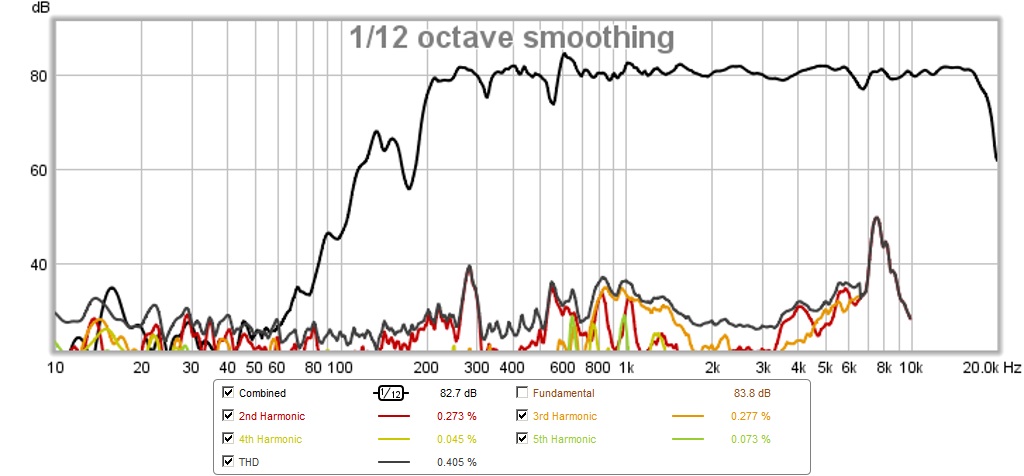
Here is the set of responses raw and with EQ etc, showing all the sahping required in DSP to get it flat. I try to only use attenuation filters, no boost (or if needed, very minor):
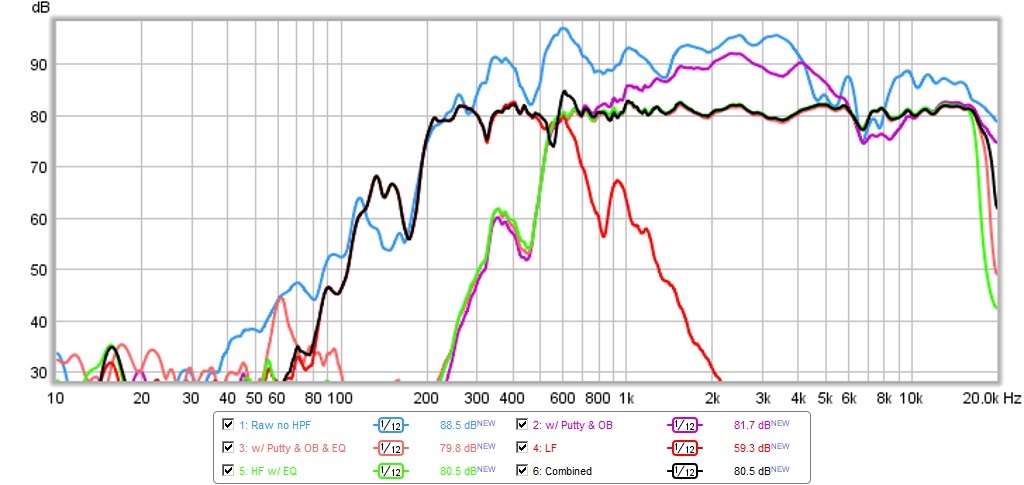
I think with careful throat design and improved injection slot ports etc, much of this can be smoothed out. As a quick and dirty demo with DSP, it works very well. Still the best speaker I have heard.
I also looked at the effect of the tailcone or Dagger on the rear wave of the AMT, and in the end went with sealed and stuffed as it reduced the phase wrap:
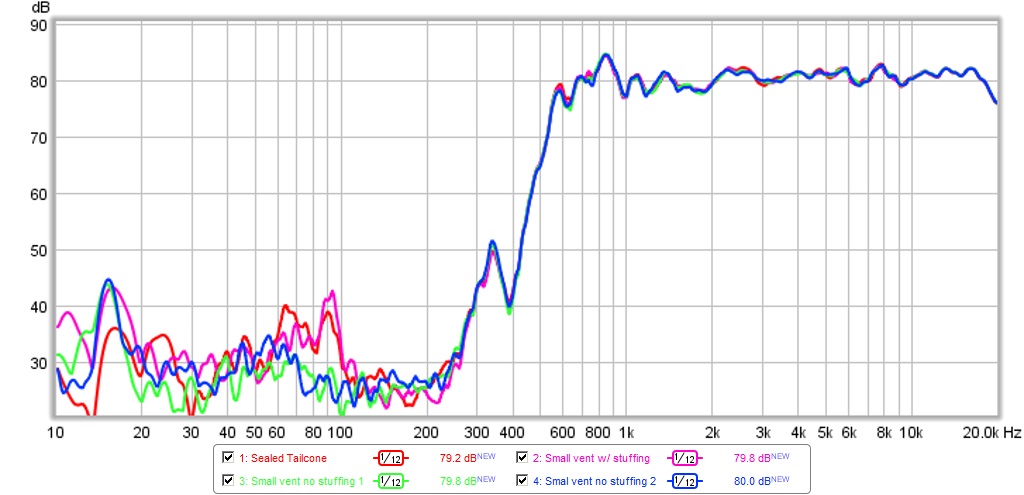
Thanks for sharing the plots.
Based on what you said, OB might work if there's a large enough barrier for the mids and the driver has a powerful enough magnet to fire into the port effectively.
I agree with eq being used largely for attenuation. I understand that even audio mastering (where there is no mechanical consequence for eq boost) uses the same principle.
- Status
- This old topic is closed. If you want to reopen this topic, contact a moderator using the "Report Post" button.
- Home
- Loudspeakers
- Multi-Way
- Unity/Synergy horn closed vs open back
